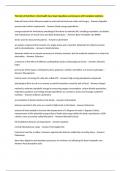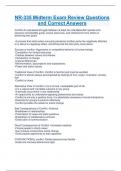The Role of Nutrition in Oral Health Care Exam Questions and Answers with Complete Solutions
External factors that influence people to seek and eat food even when not hungry. - Answers Appetite
persons total caloric requirement. - Answers Basal energy expenditure
energy required for involuntary physiological functions to maintain life, including respiration, circulation,
and maintenance of muscle tone and body temperature. - Answers Basal metabolic rate (BMR)
device used to measure kilocalories. - Answers Calorimeter
an organic compound that consists of a single amine and a catechol; obtained from dietary tyrosine
and/or phenylalanine. - Answers Catecholamines
elements similar to an enzyme necessary to activate reactions, but the molecule required is a mineral or
electrolyte. - Answers Cofactors
a measure of the effect of different carbohydrate foods on blood glucose levels. - Answers Glycemic
Index
process by which sugars, including fructose, galactose, sorbitol, and Xylitol, are stored as glycogen. -
Answers Glycogenesis
instant source of energy for cells also called ATP. - Answers High-energy phosphate compounds
physiological drive to eat or an uneasy or painful sensation caused by lack of food. - Answers Hunger
method to estimate metabolic energy by measuring oxygen consumption, carbon dioxide production,
respiratory quotient, and resting energy expenditure as a means to assess and manage a patient's
nutrition. - Answers Indirect calorimetry
accumulation of Ketone bodies in the blood. - Answers Ketoacidosis
ketones excreted in the urine as a result of high levels in the blood. - Answers Ketonuria
amount of heat needed to increase the temperature of 1 kilogram of water 1 degrees Celsius;
measurement of the potential energy value of foods and energy within the body, equivalent to 1000
calories; more accurately called kilocalorie. - Answers Kilocalorie (kcal)
fat breakdown (ketones are byproduct). - Answers Lipolysis
normal blood glucose range. - Answers Normoglycemic
instrument used by a walker; measures approximate distance walked by recording steps. - Answers
Pedometer
time when digestive and absorbent processes are minimal, not affecting the basal metabolic rate. -
Answers Post-absorptive state
,inability of the kidneys to maintain normal function of excreting toxic waste materials. - Answers Renal
failure
increase in metabolism that occurs during digestion, absorption, and Metabolism of energy-yielding
nutrients. - Answers Thermic effect
Ingestion of the _____________; carbs, lipids, proteins, water, alcohol;
Process of ________________ breaks macros down into their respective monomers; ______________,
___________________, __________________,
supplying physiologic __________ delivered to our _________, where they are used for specific
purposes by __________ - Answers Ingestion of macronutrients; carbs, lipids, proteins, water, alcohol
>digestion breaks macros down into monomers; glucose, fatty acids, and amino acids>supplying
physiologic energy delivered to our cells, where they are used for specific purposes by enzymes
______________=continuous process whereby living organisms and cells convert nutrients into
_________, _____________-____________, and ___________ - Answers Metabolism=continuous
process whereby living organisms and cells convert nutrients into energy, body structure, and waste.
Two major chemical reactions;
____________ (breaks things down to get energy)
and ____________ (uses energy to build things) - Answers Two major chemical reactions; catabolism
(breaks things down to get energy) and anabolism (uses energy to build things)
****DH note; This is why the high turnover rate for oral tissues (3-7 days) is possible. Anabolism and
catabolism are in balance, so the tissues are replaced as they are broken down.
Examples of anabolism;
Building of new muscle tissue or bone and a secretion of cellular products such as ____________.
Anabolism involves the use of ____________, ______________, _____________, and __________ to
make substances that comprise the body itself, and others necessary for proper functioning. All
nutrients are intertwined in this process.
Hormones; ___________ ______________s produced by a group of __________ that ___________ or
__________ the functions of other _________. Control different ______________ functions that affect
secretions and ___________. - Answers Examples of anabolism;
Building of new muscle tissue or bone and a secretion of cellular products such as hormones.
Anabolism involves the use of glucose, amino acids, fatty acids, and glycerol to make substances that
comprise the body itself and others necessary for proper functioning. All nutrients are intertwined in
this process.
, Hormones; Chemical messengers produced by a group of cells that stimulate or slow the functions of
other cells. Control different metabolic functions that affect secretions and growth.
Other phases of metabolism: Delivery of ____________ to cells where they are needed, and delivery of
__________ products to sites where they can be _______________. - Answers Other phases of
metabolism: Delivery of nutrients to cells where they are needed, and delivery of waste products to
sites where they can be excreted .
After the macronutrients monomers are ___________ they can be used to yield ____________ via a
common pathway within the ______________ of cells (the powerhouse of the cell)
By-products of breaking down the macronutrients are; _________, _________, ____________, and
___________. And ____________ also, but only for proteins. - Answers After the macronutrients
monomers are absorbed they can be used to yield energy via a common pathway within the
mitochondria of cells (the powerhouse of the cell)
By-products of breaking down the macronutrients are; carbon dioxide, water, and energy. And nitrogen
also, but only for proteins.
(TCA cycle) The citric acid cycle converts ________, _________, and ________ to a ___________ form of
______________, requiring many ____________. - Answers (TCA cycle) The citric acid cycle converts
glucose, fatty acids, and amino acids to a usable form of energy, requiring many enzymes.
**Some of these enzymes need specific vitamins or minerals to do this.
An enzyme that needs vitamins for activation is called a ____________. - Answers An enzyme that needs
vitamins for activation is called a coenzyme.
_________, ____________, and ___________ are B vitamins essential to coenzymes in the TCA cycle. -
Answers Thiamin, riboflavin, niacin are B vitamins essential to coenzymes in the TCA cycle.
An enzyme that needs minerals or electrolytes for activation is called a __________. _____________
function the same way as a ____________. - Answers An enzyme that needs minerals or electrolytes for
activation is called a cofactor. Cofactors function the same way as a coenzyme.
Common Electrolytes;
__________, ____________, ___________, ____________, _____________, ____________.
Electrolyte mnemonic; "Please Can Someone Make Me Cake?" - Answers Common Electrolytes;
Potassium, chloride, sodium, manganese, magnesium, calcium.
Krebs cycle quick explanation sentence;
"we burn ___________, in the presence of ___________, to create ___________ for energy, with
byproducts of __________ and ________________" - Answers Krebs cycle quick explanation sentence;





